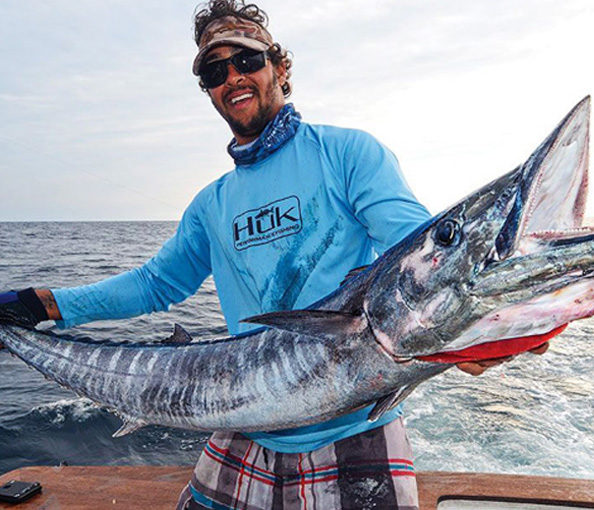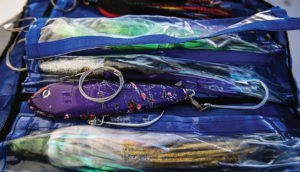Costa Rica Fishing Species Spotlight – Meet the Wahoo
Species Spotlight: Wahoo
By Florida Sport Fishing Magazine
The food chain throughout their range, they are still susceptible to predation by a variety of larger species with indiscriminate diets. Near Australia’s Great Barrier Reef, crews deploying large baits for colossal black marlin sometimes include rigged wahoo, while in other parts of their range various billfish and pelagic sharks are among the few predators capable of successfully keeping pace with these speedy game fish.
Fishing Methods
Wahoo can be difficult to pattern across much of their global range, with many encounters occurring at random. However, along the Eastern Seaboard and in The Bahamas their migrations are somewhat predictable and there are several methods by which these fish can be captured with relative consistency. In any scenario, wahoo are rarely caught on monofilament or fluorocarbon leader material, so wire or cable leaders are recommended. High-speed trolling at 15+ knots is a popular tactic in Florida and The Bahamas because it allows anglers to cover more water, but where there is one wahoo there are often others nearby. Burning fuel can be fun, but after finding the pack it’s a good idea to pull back the throttles and circle back to the same general area dragging horse ballyhoo or handcrafted strip baits. Planers are also effective in getting offerings below the surface where wahoo bites are more likely. Sailfish anglers often lose entire kite spreads when wahoo key in on lively surface baits like goggle eye and threadfin herring, which can also be deployed on downriggers when targeting ‘hoo. When floating debris or sargassum mats are encountered miles offshore, anglers also entice wahoo by dropping jigs deep beneath the shadows.

Preferred Water Temperature
78ºF
Range
Wahoo are highly migratory and maintain a presence in tropical and subtropical waters worldwide, roaming the Atlantic, Pacific and Indian oceans, including the Caribbean and Mediterranean seas. These impressive predators, like many pelagic game fish, spend much of their lives in search of ideal bands of water temperature with concentrations of forage. Unfortunately, tagging studies indicate that a wahoo’s migration pattern isn’t as simple as one would think.
Hot Spots
Wahoo can be caught virtually any day of the year around the state’s expansive coastline and throughout The Bahamas, though certain areas are more likely to produce these fish than others. Off Florida’s First Coast, anglers who fight the cold weather and rough seas common to the winter months find fast action 50 or more miles offshore near temperature breaks and changes in bottom contour. Along the state’s southeast coast and particularly in the Florida Keys, wahoo can be caught much closer to shore with a variety of tactics. Just outside the reef edge in roughly 100 to 300 feet of water, winter wahoo take advantage of the abundance of baitfish in the region. Wahoo are also present in the Gulf of Mexico, albeit much farther offshore. Here, distant oil rigs are known to have monster ‘hoo lurking nearby, while areas above abrupt changes in bottom contour also attract these delicious game fish. While the distant waters of the Bahamian Out Islands and Costa Rica produce quality catches every winter, the biggest wahoo in the world undeniably exist off Fiji and the French Polynesia.
Similar Species
Members of the Scombridae family, which includes the most prized species of mackerel and tuna, wahoo bear a customary fish silhouette featuring two dorsal fins, a slender caudal peduncle and deeply forked tail. While all scombrids have comparable biological features, in terms of behavior and where it hunts and lives, wahoo are more similar to billfish and tuna than coastal cruising king mackerel.
Minimum Length
None (state, federal and Bahamian waters).
Daily Bag Limit
2 per person, per day (state and federal waters). 18 per vessel per day, included in 18 migratory fish aggregate
Coloring
Wahoo are among the most recognizable pelagic offshore game fish around the world, sporting a unique appearance that features dark blue, purple or even greenish coloration on their backs with silvery lower sides and bellies. These fish also have 24-30 wavy, vertical bars on their sides.
Size
In Florida’s surrounding offshore waters, just about any wahoo caught that eclipses the 40-pound mark is considered a trophy. However, these tenacious game fish are capable of growing much larger and regularly push 100 pounds throughout their range. Florida’s state record wahoo, caught near Marathon, weighed 139 pounds, while the world record captured near Cabo San Lucas, Mexico weighed in at 184 pounds. Similar to several other pelagic game fish, wahoo demonstrate very fast growth rates and relatively short life spans.
Photography: Mike Haan
Food Value
Although wahoo yield incredible sporting quality with exhilarating strikes and screaming runs, perhaps the most desirable attribute is their food quality. With mild, firm white flesh, wahoo is delicious grilled, fried, blackened and baked, though many agree that nothing beats ceviche or sashimi. In Hawaii, wahoo are commonly referred to as ono, translating loosely to “good to eat.” (Get some tips for maximizing yield of fresh wahoo here)
Check out our recipe for grilled wahoo.
Conservation Status
The worldwide wahoo population is considered stable, though relatively unknown, and its conservation status is currently of little concern to fisheries managers. Though there are various protected areas throughout the wahoo’s range, there are limited species-specific conservation measures in place for these fish. In Florida, wahoo is one of many unregulated species, meaning there are no size limits and the bag limit is set at two fish per person, per day. Despite a lack of major threats, anglers should remain sensible when harvesting any fish.
Feeding
Armed with streamlined fusiform bodies, wahoo are perhaps the fastest game fish roaming the open ocean. Combined with considerable speed, razor-sharp teeth make these fish extremely proficient predators. Throughout much of their life cycles, wahoo feed on a variety of pelagic baitfish and squid, while mature specimens are capable of taking down small tuna, dolphin and more. Because wahoo possess rapid growth rates and are constantly on the move, these fish require a great deal of food and are almost always on the hunt.
[post-carousel-pro id=”5537″]
Related Costa Rica Fishing Articles
Costa Rica Fishing Species Pacific Sailfish























